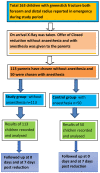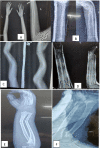Possibility of Avoiding Anesthesia in the Reduction of Greenstick and Angulated Forearm and Distal-End Radius Fractures in Children: A Comparative Study
- PMID: 37313105
- PMCID: PMC10259629
- DOI: 10.7759/cureus.38966
Possibility of Avoiding Anesthesia in the Reduction of Greenstick and Angulated Forearm and Distal-End Radius Fractures in Children: A Comparative Study
Abstract
Introduction Greenstick and angulated forearm bone fractures are the most common fractures in children and invariably require closed reduction under anesthesia. However, pediatric anesthesia is somewhat risky and not always available in developing countries like India. Therefore, this study aimed to evaluate the standard (quality) of closed reduction without anesthesia in children and to determine satisfaction among parents. Materials and methods The present study included 163 children with closed angulated fractures of the distal radius and fracture shafts of both forearm bones, who were treated by closed reduction. One hundred and thirteen were treated without any anesthesia (study group) on an outpatient department (OPD) basis, whereas 50 children of similar age and fracture type underwent reduction with anesthesia (control group). After reduction by both methods check X-ray was done to evaluate the quality of the reduction. Results The average age of the 113 children in the present study was 9.5 years (range: 3.5-16.2 years), of which 82 children had radius or ulna fractures, and 31 had isolated distal radius fractures. In 96.8% of children, ≤10° of residual angulation was achieved. Furthermore, 11 children (12.4%) used paracetamol or ibuprofen for pain control in the study group. Moreover, 97.3% of parents stated that they would like their children to be treated without anesthesia if any fracture occurred again. Conclusions Closed reduction of greenstick angulated forearm and distal-end radius fracture in children in the OPD without anesthesia achieved satisfactory reduction and high parent satisfaction while reducing the risks of pediatric anesthesia and its associated complications.
Keywords: anaesthesia; children; closed reduction; fracture angulation; greenstick fracture.
Copyright © 2023, Rai et al.
Conflict of interest statement
The authors have declared that no competing interests exist.
Figures



Similar articles
-
"You're O.K. Anesthesia": Closed Reduction of Displaced Pediatric Forearm and Wrist Fractures in the Office Without Anesthesia.J Pediatr Orthop. 2022 Nov-Dec 01;42(10):595-599. doi: 10.1097/BPO.0000000000002246. Epub 2022 Aug 22. J Pediatr Orthop. 2022. PMID: 35993589
-
Deformed pediatric forearm fractures: Predictors of successful reduction by emergency providers.Am J Emerg Med. 2021 Dec;50:59-65. doi: 10.1016/j.ajem.2021.06.073. Epub 2021 Jul 2. Am J Emerg Med. 2021. PMID: 34280709
-
Seven-year follow-up for malrotation of a radial diaphysis fracture in a child corrected by osteotomy for loss of motion: A case report.Exp Ther Med. 2019 Oct;18(4):3009-3013. doi: 10.3892/etm.2019.7932. Epub 2019 Aug 20. Exp Ther Med. 2019. PMID: 31572542 Free PMC article.
-
Forearm and distal radius fractures in children.J Am Acad Orthop Surg. 1998 May-Jun;6(3):146-56. doi: 10.5435/00124635-199805000-00002. J Am Acad Orthop Surg. 1998. PMID: 9689186 Review.
-
Common Fractures of the Radius and Ulna.Am Fam Physician. 2021 Mar 15;103(6):345-354. Am Fam Physician. 2021. PMID: 33719378 Review.
References
-
- Fracture patterns in children. Analysis of 8,682 fractures with special reference to incidence, etiology and secular changes in a Swedish urban population 1950-1979. Landin LA. https://pubmed.ncbi.nlm.nih.gov/6574687/ Acta Orthop Scand Suppl. 1983;202:1–109. - PubMed
-
- Epidemiology of childhood fractures in Britain: a study using the general practice research database. Cooper C, Dennison EM, Leufkens HG, Bishop N, van Staa TP. J Bone Miner Res. 2004;19:1976–1981. - PubMed
-
- The management of forearm fractures in children: a plea for conservatism. Jones K, Weiner DS. J Pediatr Orthop. 1999;19:811. - PubMed
-
- Epidemiology of distal forearm fractures in Danish children. Kramhøft M, Bødtker S. Acta Orthop Scand. 1988;59:557–559. - PubMed
LinkOut - more resources
Full Text Sources
